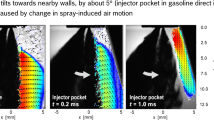Abstract
Three visualization methods, Schlieren, Shadowgraph, and Mie-scattering, were applied to compare diesel and gasoline spray structures in a constant volume chamber. Fuels were injected into a high pressure/high temperature chamber under the same in-cylinder pressure and temperature conditions of low load in a GDCI (gasoline direct injection compression ignition) engine. Two injection pressures (40 MPa and 80 MPa), two ambient pressures (4.2 MPa and 1.7 MPa), and two ambient temperatures (908 K and 677 K) were use. The images from the different methods were overlapped to show liquid and vapor phases more clearly. Vapor developments of the two fuels were similar; however, different liquid developments were seen. At the same injection pressure and ambient temperature, gasoline liquid propagated more quickly and disappeared more rapidly than diesel liquid phase. At the low ambient temperature and pressure condition, gasoline and diesel sprays with higher injection pressures showed longer liquid lengths due to higher spray momentum. At the higher ambient temperature condition, the gasoline liquid length was shorter for the higher injection pressure. Higher volatility of gasoline is the main reason for this shorter liquid length under higher injection pressure and higher ambient temperature conditions. For a design of GDCI engine, it is necessary to understand the higher volatility of gasoline.
Similar content being viewed by others
Abbreviations
- BTDC:
-
before top dead center
- GDCI:
-
gasoline direct-injection compression ignition
- CO:
-
carbon monoxide
- HC:
-
hydrocarbon
- NOx:
-
nitrogen oxides
- PM:
-
particulate matters
References
Canaan, R. E., Dec, J. E., Green, R. M. and Daly, D. T. (1998). The influence of fuel volatility on the liquidphase fuel penetration in a heavy-duty D.I. diesel engine. SAE Paper No. 980510.
Dec, J. (2009). Advanced compression-ignition engines–Understanding the in-cylinder processes. Proc. Combustion Institute 32, 2, 2727–2742.
ECN (Engine Combustion Network) (2015}). http://www.sandia.gov/ecn/cvdata/sandiaCV/ambientConditions.ph
Espey, C. and Dec, J. E. (1995). The effect of TDC temperature and density on the liquid-phase fuel penetration in a D. I. diesel engine. SAE Paper No. 952456.
Fisher, B. and Mueller, C. J. (2012). Effects of injection pressure, injection-rate shape, and heat release on liquid length. SAE Int. J. Engines 5, 2, 415–429.
Flowers, D. L., Aceves, S. M. and Babajimopoulos, A. (2006). Effect of charge non-uniformity on heat release and emissions in PCCI engine combustion. SAE Paper No. 2006-01-1363.
Heywood, J. B. (1988). Internal Combustion Engine Fundamentals. McGraw-Hill. Singapore.
Hiroyasu, H. and Arai, M. (1990). Structures of fuel sprays in diesel engines. SAE Paper No. 900475.
Kalghatgi, G. T. (2005). Auto-ignition quality of practical fuels and implications for fuel requirements of future SI and HCCI engines. SAE Paper No. 2005-01-0239.
Kalghatgi, G. T., Risberg, P. and Ångström, H. (2006). Advantages of fuels with high resistance to auto-ignition in late-injection, low-temperature, compression ignition combustion. SAE Paper No. 2006-01-3385.
Kamimoto, T. and Bae, M. (1988). High combustion temperature for the reduction of particulate in diesel engines. SAE Paper No. 880423.
Kim, K., Kim, D., Jung, Y. and Bae, C. (2013). Spray and combustion characteristics of gasoline and diesel in a direct injection compression ignition engine. Fuel, 109, 616–626.
Kook, S. and Pickett, L. M. (2011). Liquid length and vapor penetration of conventional, fischer-tropsch, coalderived, and surrogated fuel sprays at high-temperature and high-pressure ambient conditions. Fuel, 93, 539–548.
Lai, M., Zheng, Y., Xie, X., Moon, S., Liu, Z., Gao, J., Zhang, X., Fezzaa, K., Wang, J. and Shi, J. (2011). Characterization of the near-field spray and internal flow of single-hole and multi-hole sac nozzles using phase contrast x-ray imaging and CFD. SAE Int. J. Engines 4, 1, 703–719.
Montanaro, A., Migliaccio, M., Allocca, L., Fraioli, V., Lee, S., Zhang, A. and Naber, J. (2014). Schlieren and mie scattering visualization for single-hole diesel injector under vaporizing conditions with numerical validationd. SAE Paper No. 2014-01-1406.
Moon, S., Gao, Y., Park, S., Wang, J., Kurimoto, N. and Nishijima, Y. (2015). Effect of the number and position of nozzle holes on in- and near-nozzle dynamic characteristics of diesel injection. Fuel, 150, 112–122.
Nishida, K., Gao, J., Manabe, T. and Zhang, Y. (2008). Spray and mixture properties of evaporating fuel spray injected by hole-type direct injection diesel injector. Int. J. Engine Research 9, 4, 347–360.
Risberg, P., Kalghatgi, G. T. and Ångstrom, H. (2003). Auto-ignition quality of gasoline-like fuels in HCCI engines. SAE Paper No. 2003-01-3215.
Settles, G. S. (2006). Schlieren and Shadowgraph Techniques: Visualizing Phenomena in Transparent Media. Springer-Verlag Berlin Heidelberg. Heidelberg, Germany.
Shimazaki, N., Tsurushima, T. and Nishimura, T. (2003). Dual mode combustion concept with premixed diesel combustion by direct injection near top dead center. SAE Paper No. 2003-01-0742.
Siebers, D. L. (1999). Scaling liquid-phase fuel penetration in diesel sprays based on mixing-limited vaporization. SAE Paper No. 1999-01-0528.
Won, H., Bouet, A., Duffour, F. and De Francqeville, L. (2016). Potential of Naphtha fuel on a light duty single cylinder compression ignition engine. Proc. FISITA 2016, Bexco, Korea.
Author information
Authors and Affiliations
Corresponding author
Additional information
This paper was modified from the original paper presented in FISITA World Automotive Congress 2016, and recommended by the Scientific & Technical Committee for journal publication.
Rights and permissions
About this article
Cite this article
Kim, D., Park, S.S. & Bae, C. Schlieren, Shadowgraph, Mie-scattering visualization of diesel and gasoline sprays in high pressure/high temperature chamber under GDCI engine low load condition. Int.J Automot. Technol. 19, 1–8 (2018). https://doi.org/10.1007/s12239-018-0001-8
Received:
Revised:
Accepted:
Published:
Issue Date:
DOI: https://doi.org/10.1007/s12239-018-0001-8




